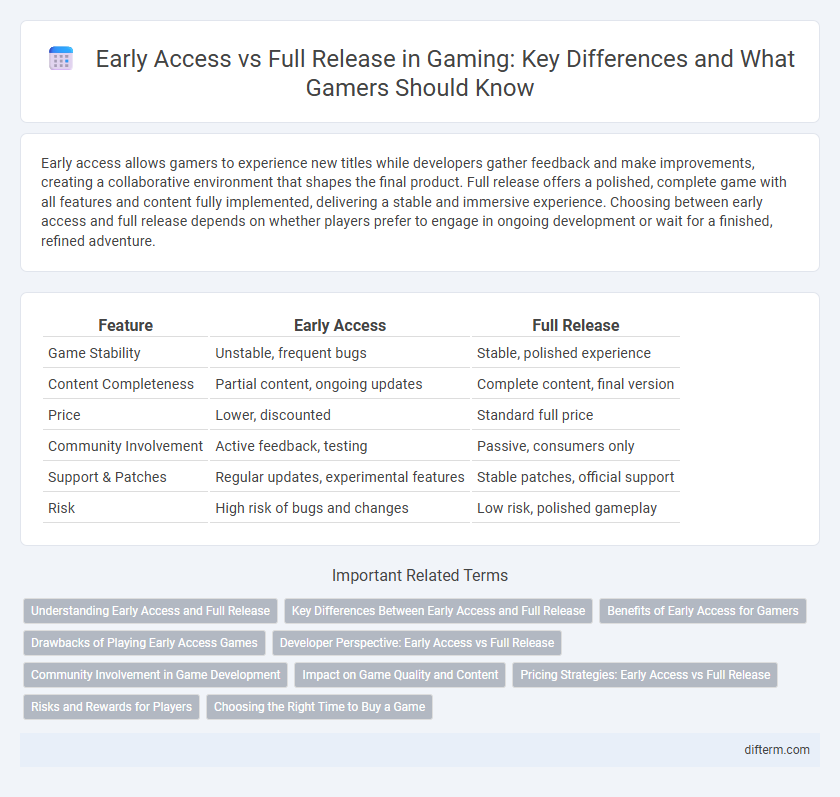Early access allows gamers to experience new titles while developers gather feedback and make improvements, creating a collaborative environment that shapes the final product. Full release offers a polished, complete game with all features and content fully implemented, delivering a stable and immersive experience. Choosing between early access and full release depends on whether players prefer to engage in ongoing development or wait for a finished, refined adventure.
Table of Comparison
| Feature | Early Access | Full Release |
|---|---|---|
| Game Stability | Unstable, frequent bugs | Stable, polished experience |
| Content Completeness | Partial content, ongoing updates | Complete content, final version |
| Price | Lower, discounted | Standard full price |
| Community Involvement | Active feedback, testing | Passive, consumers only |
| Support & Patches | Regular updates, experimental features | Stable patches, official support |
| Risk | High risk of bugs and changes | Low risk, polished gameplay |
Understanding Early Access and Full Release
Early access in gaming allows players to experience a game during its development phase, providing valuable feedback that influences final improvements. Full release marks the official launch when a game is polished, complete, and optimized for performance across platforms. Understanding the difference helps gamers decide between participating in development or enjoying a finished, stable product.
Key Differences Between Early Access and Full Release
Early access games provide players with an opportunity to experience and influence gameplay during development, often featuring incomplete content, regular updates, and potential bugs. Full release titles offer a polished, stable experience with complete content, finalized mechanics, and broader platform compatibility. Player feedback in early access directly shapes game progression, whereas full release focuses on delivering a finished product optimized for performance and market readiness.
Benefits of Early Access for Gamers
Early access provides gamers with the opportunity to influence game development through direct feedback, allowing for a more tailored and polished final product. It offers early enjoyment of new content and features, fostering a dedicated community that collaborates closely with developers. Access to evolving gameplay and exclusive updates rewards players with unique experiences unavailable in the full release.
Drawbacks of Playing Early Access Games
Playing early access games often involves encountering numerous bugs, incomplete features, and frequent updates that can disrupt gameplay. Performance optimization is usually lacking, leading to crashes or slowdowns on various hardware. Early access titles may also experience sudden changes in game direction, causing player progress to be lost or content to become obsolete.
Developer Perspective: Early Access vs Full Release
Early access allows developers to gather real-time player feedback, identify bugs, and iterate on game mechanics before the full release, reducing post-launch issues and enhancing player satisfaction. It helps in securing funding through early sales and building a community that contributes to game improvements and stability. Full release demands a polished, bug-free experience, requiring significant development time and resources to meet player expectations and establish a strong market presence.
Community Involvement in Game Development
Early access games enable players to participate in the development process by providing real-time feedback and reporting bugs, fostering a collaborative community environment. This continuous interaction helps developers refine gameplay mechanics, balance features, and address technical issues before the full release. Community involvement during early access stages not only builds player loyalty but also results in a more polished and player-centric final product.
Impact on Game Quality and Content
Early access allows developers to gather player feedback and identify bugs, resulting in iterative improvements that enhance game quality over time. However, full release typically offers a more polished experience with complete content and fewer technical issues. Balancing player input from early access with final content refinement ensures a well-rounded gaming experience.
Pricing Strategies: Early Access vs Full Release
Early access pricing often features a discounted rate to attract early adopters and generate initial revenue, creating a sense of value for players willing to support development. Full release pricing typically reflects the complete game experience, with a higher price point justified by polished content, additional features, and bug fixes. Developers use early access pricing to fund ongoing development while gauging market demand, whereas full release pricing aims to maximize profit from a finalized product.
Risks and Rewards for Players
Early access games offer players unique opportunities to influence development and access content before official launch, but they also carry risks such as bugs, incomplete features, and potential abandonment. Full releases provide polished, stable experiences with complete content, reducing frustration and ensuring long-term support. Players must weigh the reward of early involvement and potential lower costs against the risk of encountering unstable gameplay and limited updates.
Choosing the Right Time to Buy a Game
Purchasing a game during early access allows players to experience new content and provide feedback that can shape development, often at a lower initial price. Full release versions offer polished gameplay, complete features, and usually fewer bugs, ensuring a more stable and immersive experience. Gamers should assess factors like their tolerance for unfinished content, desire for involvement in game development, and readiness for a finalized product when deciding the optimal time to buy.
early access vs full release Infographic

 difterm.com
difterm.com